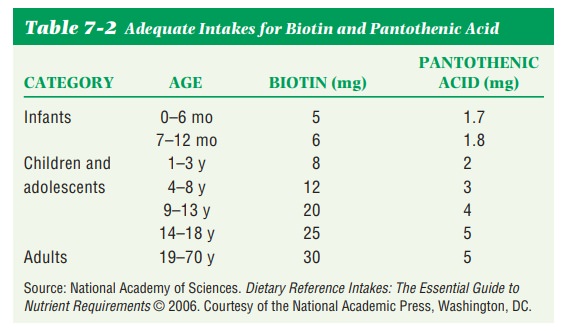Chapter: Nutrition and Diet Therapy: Vitamins
Dietary Requirements of Vitamins
DIETARY REQUIREMENTS
Since 1997, the Food and Nutrition Board of the Institute of Medicine has been establishing Dietary Reference Intakes (DRIs) to replace the Recommended Di-etary Allowances (RDAs) as outlined in Table 7-2. Tolerable Upper Limits (ULs) have also been set for some vitamins and minerals. The UL is the maximum level of daily intake unlikely to cause adverse effects and is not a recommended level of intake. Vitamin allowances are given by weight—milligrams (mg) or micrograms (μg or mcg).

Vitamin deficiencies
can occur and can result in disease. Persons inclined to vitamin deficiencies
because they do not eat balanced diets include alcoholics, the poor and
incapacitated elderly, patients with serious diseases that affect appetite,
mentally retarded persons, and young children who receive inadequate care.
Also, deficiencies of fat-soluble vitamins occur in patients with chronic
malabsorption diseases such as cystic fibrosis, celiac disease, and Crohn’s
disease.
The term avitaminosis means “without
vitamins.” This word followed by the name of a specific vitamin is used to
indicate a serious lack of that partic-ular vitamin. Hypervitaminosis is the excess of one
or more vitamins. Either a lack or excess of vitamins can be detrimental to a
person’s health.
Vitamins taken in
addition to those received in the diet are called vitaminsupplements.
These are available in concentrated forms in tablets,
capsules,and drops. Vitamin concentrates are sometimes termed natural or synthetic (manufactured). Some people believe that a meaningful
difference exists between the two types and that the natural are far superior
in quality to the synthetic. However, according to the U.S. Food and Drug
Administration (FDA), the body cannot distinguish between a vitamin of plant or
animal origin and one manu-factured in a laboratory because once they have been
dismantled by the digestive system, the two types of the same vitamin are
chemically identical.
Synthetic vitamins are
frequently added to foods during processing. When this is done, the foods are
described as enriched or fortified. Examples of these foods are enriched breads
and cereals to which thiamine, niacin, ribofla-vin, folate, and the mineral
iron have been added. Vitamins A and D are added to milk and fortified
margarine.
Preserving Vitamin Content in Food
Occasionally, vitamins
are lost during food processing. In most cases, food producers can replace
these vitamins with synthetic vitamins, making the processed food nutritionally
equal to the unprocessed food. Foods in which vitamins have been replaced are
called restored foods.
Because some vitamins
are easily destroyed by light, air, heat, and water, it is important to know
how to preserve the vitamin content of food during its preparation and cooking.
Vitamin loss can be avoided by the following:
• Buying the freshest, unbruised vegetables and fruits locally
andusing them raw whenever possible
• Preparing fresh vegetables and fruits just before serving
• Heating canned vegetables quickly and in their own liquid
• Following package directions when using frozen vegetables or
fruit
• Using as little water as possible when cooking and having it
boiling before adding vegetables, or, preferably, steaming them
• Covering the pan, cooking vegetables until bright in color
andcrisp tender
• Saving any cooking liquid for later use in soups, stews, and
gravies
• Storing fresh vegetables and most fruits in a cool, dark place
• Microwave fruits and vegetables in 1 to 2 tablespoons of water
Related Topics